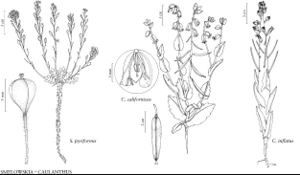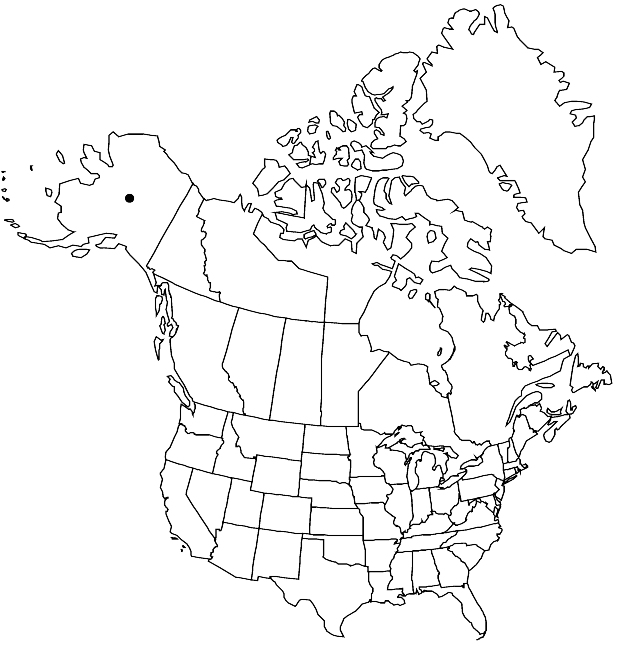Difference between revisions of "Smelowskia pyriformis"
Rhodora 54: 108, fig. 3B. 1952.
FNA>Volume Importer |
imported>Volume Importer |
||
| (6 intermediate revisions by 2 users not shown) | |||
| Line 6: | Line 6: | ||
|place=54: 108, fig. 3B. 1952 | |place=54: 108, fig. 3B. 1952 | ||
|year=1952 | |year=1952 | ||
| + | }} | ||
| + | |special_status={{Treatment/ID/Special_status | ||
| + | |code=F | ||
| + | |label=Illustrated | ||
| + | }}{{Treatment/ID/Special_status | ||
| + | |code=E | ||
| + | |label=Endemic | ||
| + | }}{{Treatment/ID/Special_status | ||
| + | |code=C | ||
| + | |label=Conservation concern | ||
}} | }} | ||
|basionyms= | |basionyms= | ||
| Line 32: | Line 42: | ||
-->{{#Taxon: | -->{{#Taxon: | ||
name=Smelowskia pyriformis | name=Smelowskia pyriformis | ||
| − | |||
|authority=W. H. Drury & Rollins | |authority=W. H. Drury & Rollins | ||
|rank=species | |rank=species | ||
| Line 46: | Line 55: | ||
|publication title=Rhodora | |publication title=Rhodora | ||
|publication year=1952 | |publication year=1952 | ||
| − | |special status= | + | |special status=Illustrated;Endemic;Conservation concern |
| − | |source xml=https:// | + | |source xml=https://bitbucket.org/aafc-mbb/fna-data-curation/src/2e0870ddd59836b60bcf96646a41e87ea5a5943a/coarse_grained_fna_xml/V7/V7_1159.xml |
|tribe=Brassicaceae tribe Smelowskieae | |tribe=Brassicaceae tribe Smelowskieae | ||
|genus=Smelowskia | |genus=Smelowskia | ||
Latest revision as of 22:30, 5 November 2020
Plants sometimes canescent throughout; caudex simple. Stems: usually several, rarely simple from base, usually unbranched, rarely branched, 0.5–2.4(–3) dm, trichomes simple, to 1.3 mm, mixed with smaller, dendritic ones. Basal leaves: petiole 1–4 cm, often ciliate, trichomes simple; blade broadly ovate to oblong in outline, (terminal segments oblong to or ovate), 1–2.2 cm × 8–15 mm, (terminal segments 0.4–1 cm × 1.5–3 mm), margins pinnatifid, apex obtuse. Cauline leaves shortly petiolate or sessile; blade similar to basal, smaller distally. Racemes considerably elongated in fruit. Fruiting pedicels ascending to divaricate-ascending, (often forming less than 40˚ angle), proximalmost bracteate, 5–15(–20) mm, pubescent, trichomes simple (to 1.4 mm), mixed with smaller, dendritic ones. Flowers: sepals 1.2–2.2 mm; petals purple, lavender, or white, suborbicular to obovate, 2.5–4.5 × 1–2.5 mm, narrowed to claw, 1–2 mm, apex rounded; anthers ovate, 0.3–0.5 mm. Fruits ascending, pyriform, subterete, 5–9 × 2.5–4 mm, base cuneate, apex rounded; valves each with prominent midvein; ovules 4 per ovary; style 0.4–1.2 mm. Seeds (oblong-lanceolate) 2.5–3.2 × 1–1.5 mm. 2n = 12.
Phenology: Flowering Jun–Aug.
Habitat: Loose talus, scree slopes, shale ridgetops, limestone volcanic rubble, mixed sandstone-siltstone-carbonate scree
Elevation: 600-1700 m
Discussion
Of conservation concern.
Selected References
None.

